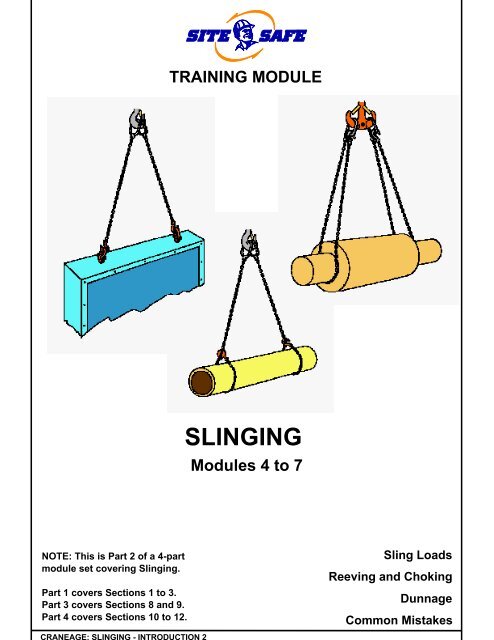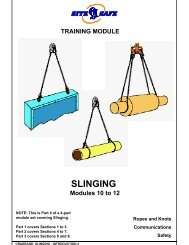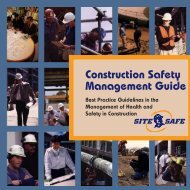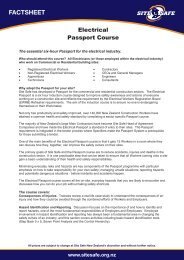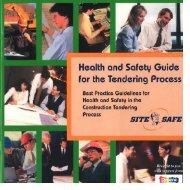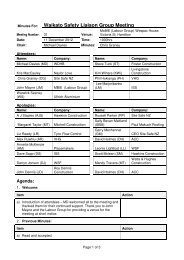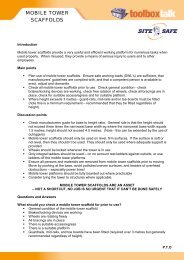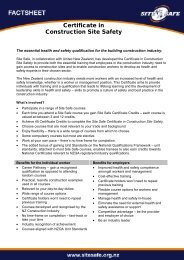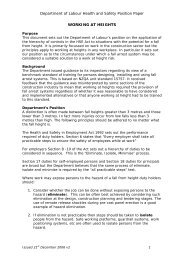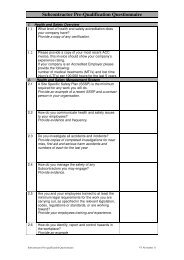You also want an ePaper? Increase the reach of your titles
YUMPU automatically turns print PDFs into web optimized ePapers that Google loves.
NOTE: This is Part 2 of a 4-part<br />
module set covering Slinging.<br />
Part 1 covers Sections 1 to 3.<br />
Part 3 covers Sections 8 and 9.<br />
Part 4 covers Sections 10 to 12.<br />
CRANEAGE: SLINGING - INTRODUCTION 2<br />
TRAINING MODULE<br />
SLINGING<br />
Modules 4 to 7<br />
Sling Loads<br />
Reeving and Choking<br />
Dunnage<br />
Common Mistakes
SLINGING<br />
Modules 4 to 7<br />
This Training Module comes to you courtesy of:<br />
<strong>Site</strong> <strong>Safe</strong> would like to acknowledge Fletcher Construction’s on-going support<br />
CRANEAGE: SLINGING - INTRODUCTION 2
CRANEAGE - SLINGING BASICS<br />
SECTION 4:<br />
KNOW YOUR SLING LOADS<br />
4.1 Know how to work out Sling Loads<br />
4.2 Sling Loads Formula<br />
4.3 Two-Legged Slings<br />
4.4 Three-Legged Slings<br />
4.5 Four-Legged Slings<br />
4.6 Four-Legged Slings: worked examples<br />
CRANEAGE - SLINGING: BASICS PAGE 1
GOOD SLINGING PRACTICE<br />
BASIC RULES ... 4<br />
4.1. KNOW HOW TO WORK OUT SLING LOADS.<br />
You now know the importance of the included angle in <strong>slinging</strong>.<br />
It then becomes necessary to establish the loads actually being carried by slings.<br />
This can be done with nothing more complicated than a tape measure and a simple<br />
pocket calculator, and not having to become involved in degrees and angles.<br />
Not more<br />
than 45° Angle up to 90° Slings<br />
Load<br />
S.W.L. x 1.4 = <strong>Safe</strong> Working Load.<br />
(Don't crowd the<br />
hook!)<br />
L = Length<br />
W = weight<br />
Angle to the<br />
vertical<br />
V =<br />
Height<br />
CRANEAGE - SLINGING: BASICS PAGE 2
GOOD SLINGING PRACTICE<br />
BASIC RULES ... 4<br />
4.2. KNOW HOW TO WORK OUT SLING LOADS.<br />
This formula is very accurate, and allows you to use a tape measure for calculations,<br />
rather than having to use degrees and angles.<br />
The formula is: T = W x L<br />
N V<br />
T = Tension per leg in kg<br />
W = weight in kg<br />
N = number of legs<br />
L = sling length in metres<br />
V = vertical height in metres<br />
Example:<br />
W = weight = 5,000 kg<br />
N = No. of legs = 2<br />
V = vertical height = 2 metres<br />
L = sling length = 3.5 metres<br />
T = 5000 kg x 3.5<br />
2 2<br />
=<br />
17,500<br />
4<br />
L = Length<br />
= 4,375 kg per leg.<br />
You would need a two-legged sling rated at 5,000kg WLL capacity per leg.<br />
W = weight<br />
This formula will work for any number of sling legs, but as we all know, a four leg sling<br />
system can often mean that only two legs are carrying all the weight, with the other two<br />
legs doing little more than acting as balancing legs.<br />
Refer to Sheets 4.5 and 4.6 for details of four-leg slings.<br />
Therefore, use the formula based on TWO legs only, to make sure that you are on the<br />
safe side.<br />
It's too late to be checking your calculations when the load has<br />
fallen to the ground.<br />
CRANEAGE - SLINGING: BASICS PAGE 3<br />
V =<br />
Height
GOOD SLINGING PRACTICE<br />
BASIC RULES ... 4<br />
4.3. SAFE WORKING LOADS - TWO-LEG SLINGS.<br />
The modern method of rating slings is by their working load limit (WLL), which<br />
rates the sling in pure tension (that is, vertical). The safe working load (SWL)includrefers ed angles on sling loads.<br />
to the rigging system being used - that is, sling angles, reeving, number of sling legs,<br />
and the like.<br />
Using our Riggers' Guide, we find for<br />
this system:<br />
1. the SWL = 4500 kg.<br />
2. the WLL of each sling = 3200 kg.<br />
3. the load in each sling leg will be<br />
the actual load x 0.7.<br />
4. the SWL = WLL of ONE sling leg<br />
divided by 0.7.<br />
Note: Older slings will be<br />
rated as SWL for straight lift<br />
or pull. In this case, use the<br />
SWL in your calculations.<br />
As an example:<br />
1. Each leg of a two-leg sling has a WLL of 100 kg.<br />
The included angle between the legs of the sling<br />
is not more than 60°.<br />
<strong>Safe</strong> working load = (100 / 0.58) = 172 kg.<br />
2. Should the included angle between legs be<br />
increased to 120°;<br />
the S.W.L. = (100 / 1) = 100 kg.<br />
3. The load is 100 kg, and the included angle is 30°.<br />
Sling load = 100 kg x 0.52 = 52 kg per leg.<br />
Refer to the chart at right for the effect of<br />
included angles on sling loads<br />
90°<br />
Load<br />
10mm<br />
Chain<br />
Slings<br />
This chart is in the Riggers Guide<br />
EFFECT OF INCLUDED ANGLE<br />
ON SLING LOADS<br />
0.5 t 0.5 t<br />
Load<br />
in<br />
tonnes<br />
30°<br />
0.52<br />
60°<br />
0.58<br />
90°<br />
120°<br />
0.7<br />
1.0<br />
151° 2.0<br />
171° 6.0<br />
1 tonne load
GOOD SLINGING PRACTICE<br />
BASIC RULES ... 4<br />
4.4. SAFE WORKING LOADS - THREE-LEG SLINGS.<br />
Three-leg slings need special consideration, because rarely do all three legs take an<br />
equal share of the load. It is best to assume that only TWO legs are sharing the load,<br />
with the third leg only acting as a "balancer".<br />
Using our Riggers' Guide, we find for<br />
this system:<br />
1. the SWL = 4500 kg.<br />
2. the WLL of each sling = 3200 kg.<br />
3. the load in each sling leg will be<br />
the actual load x 0.7.<br />
4. the SWL = WLL of ONE sling leg<br />
divided by 0.7.<br />
If loads are critical and equally shared we can find accurate<br />
sling loads by calculation - e.g; using the same scenario,<br />
10mm chain slings with a WLL of 3200 kg and effective 90°<br />
included angle has a SWL of (3200 / 0.7) = 2286 kg per leg.<br />
= 6857 kg for the three legs.<br />
As an example:<br />
Sling legs are 3m long.<br />
Pitch diameter of the sling attachments is 3m.<br />
The effective included angle is 60° (30° from<br />
vertical).<br />
Using the approximation method, we assume the<br />
load is taken on two legs only. Therefore, from our<br />
Riggers Chart, we find the sling load at 60°<br />
included angle will be 100 kg x 0.58 (60° load<br />
factor) = 58 kg.<br />
Assuming the load is equally distributed between<br />
the three legs, we find that the sling load =<br />
100 kg x 0.58 (60° load factor) x<br />
2 legs<br />
3 legs<br />
= 39 kg.<br />
Assumed included<br />
angle = 90°.<br />
= 45° to vertical.<br />
Load = 100 kg.<br />
10mm chain<br />
slings<br />
CRANEAGE - SLINGING: BASICS PAGE 5
GOOD SLINGING PRACTICE<br />
BASIC RULES ... 4<br />
4.5. SAFE WORKING LOADS - FOUR-LEG SLINGS.<br />
You will have noticed that the<br />
Riggers Chart treats 2, 3 and 4 leg<br />
slings as having the same SWL for<br />
various configurations.<br />
With a 4-leg sling, unless a<br />
load-sharing device exists in the<br />
system, the load will ALWAYS be<br />
taken by TWO slings only.<br />
The other two will only serve to<br />
balance the load.<br />
Angle to<br />
vertical<br />
Included angle is<br />
between two<br />
opposite legs.<br />
The reason for this situation is that it is virtually impossible for the length of the slings to be<br />
exactly equal, and the placement of the slings to load attachment points to be such that the<br />
distance from their underside to the crane hook is exactly equal.<br />
If the load is flexible, some sharing of the load will take place as the load twists.<br />
The degree of sharing is dependent on the stiffness of the load. If the effect of this stiffness is<br />
unknown, we MUST assume it to be perfectly stiff, and NO load sharing takes place.<br />
Sling calculations are therefore the same as for two-leg slings (see Sheet 4.3).<br />
Of special concern with precast slung from four points,<br />
is the capacity of the pin anchors.<br />
Let's see, now. Ten tons to pick up -<br />
4 x 2.5 tonne pins = 10 tonnes.<br />
10mm chains ought to do.<br />
Sweet, eh!<br />
OH, REALLY?<br />
Remember that one leg at least<br />
will be slack, and the load will<br />
then be carried by only two<br />
slings. Therefore, the included<br />
angle must be 90°.<br />
Sling angle = 90°.<br />
Sling load must be 7.0 tonnes.<br />
Therefore, 4 x 10-tonne pins<br />
are required, and 16mm chains.<br />
Some difference!<br />
2.5 pin<br />
anchors<br />
10 TONNES<br />
8.5m<br />
across diagonals<br />
CRANEAGE - SLINGING: BASICS PAGE 6<br />
6m<br />
10mm<br />
chain<br />
slings
GOOD SLINGING PRACTICE<br />
BASIC RULES ... 4<br />
4.6 LOAD SHARING DEVICES<br />
These are examples of load sharing devices which distribute a load equally among<br />
sling legs.<br />
One side slung with<br />
fixed slings, the other<br />
side using a delta<br />
plate to ensure all<br />
slings are equally<br />
loaded.<br />
SWL 6.0 T<br />
Use a lifting beam<br />
with two sets of two<br />
leg slings, to ensure<br />
all legs are equally<br />
loaded.<br />
Alternative -<br />
use a snatch<br />
block.<br />
Use short<br />
two-leg slings<br />
and a further<br />
set of<br />
two-legs, to<br />
ensure equal<br />
load sharing.<br />
CRANEAGE - SLINGING BASICS PAGE 7
GENERALLY LIMIT FOR SAFE CRANE OPERATION. REFER TO SPECIFIC CRANE MANUAL.<br />
BEAUFORT WIND SCALE<br />
Beaufort<br />
Number<br />
0<br />
1<br />
2<br />
3<br />
4<br />
Description Observed Features<br />
Calm Smoke rises vertically<br />
Light<br />
Air<br />
Light<br />
Breeze<br />
Gentle<br />
Breeze<br />
Moderate<br />
Breeze<br />
Smoke drifts downwind. Wind<br />
does not move wind vane.<br />
Wind felt on face. Leaves rustle.<br />
Wind vane moved by wind.<br />
Leaves and twigs in constant<br />
motion. Wind extends light flag.<br />
Raises dust and loose paper.<br />
Small branches are moved.<br />
Velocity<br />
in MPH<br />
Less<br />
than 1<br />
Velocity<br />
in KPH<br />
Less<br />
than 1.6<br />
1 - 3 2 - 5<br />
4 - 7 6 - 11<br />
8 -12 13 -19<br />
13 - 18 21 - 29<br />
Small trees in leaf begin tomsway.<br />
Fresh<br />
5 Crested wavelets form on inland 19 - 24 31 - 39<br />
Breeze<br />
waters.<br />
Strong Large branches in motion;<br />
6 25 - 31 40 - 50<br />
Breeze whistling heard in power wires.<br />
Whole trees in motion.<br />
Moderate<br />
7 Inconvenience felt in walking<br />
32 - 38 52 - 61<br />
Gale<br />
against wind.<br />
Fresh Twigs break off trees, progress<br />
8 39 - 46 63 - 74<br />
Gale generally impeded.<br />
Slight structural damage occurs<br />
Strong<br />
9 (roof tiles and chimney pots<br />
47 - 54 76 - 87<br />
Gale<br />
removed).<br />
Seldom experienced inland;<br />
Whole<br />
10 trees uprooted, considerable<br />
55 - 63 88 - 101<br />
Gale<br />
structural damage.<br />
Very rarely experienced; causes<br />
11 Storm<br />
64 - 75 103 - 121<br />
widespread destruction.<br />
12<br />
Hurricane<br />
Note: Velocity is measured approx. 6 metres (20ft) above ground level.<br />
BEAUFORT WIND SCALE PAGE 8<br />
Over<br />
75<br />
Over<br />
121
CRANEAGE - SLINGING BASICS<br />
SECTION 5:<br />
REEVING AND CHOKING<br />
5.1 Know the Effect of Reeving on Slings<br />
5.2 The Nip Angle<br />
CRANEAGE - SLINGING: BASICS PAGE 9
GOOD SLINGING PRACTICE<br />
BASIC RULES ... 5<br />
5.1. KNOW THE EFFECT OF REEVING ON SLINGS.<br />
"Reeving" is the <strong>practice</strong> of wrapping a sling around an object, and either doubling it<br />
back on the hook, or passing one eye of the sling through the other and then to the<br />
hook.<br />
This <strong>practice</strong> is also known as "choking", or "nipping".<br />
This <strong>practice</strong> is perfectly safe when done properly, BUT you MUST realise that the act<br />
of reeving creates an "included angle" within the sling which reduces the permissible<br />
load on that sling.<br />
And NEVER bang the hook down on to the load. You are NOT making the sling more<br />
secure - in fact, you are creating larger loads in the sling by increasing the included<br />
angle.<br />
It also increases the crushing force on the load.<br />
Any sling reeved around a load needs to have a SWL which is<br />
TWICE that of a vertical sling.<br />
To work out the sling loads for a reeved sling, use the following formula.<br />
This will work for any reeved sling with an included angle LESS that<br />
120°, which must be the absolute maximum angle.<br />
An example has been shown.<br />
R<br />
Load = W.<br />
Note protection on sharp corners.<br />
L<br />
T = Tension in each <strong>slinging</strong> leg.<br />
L = Length of each leg.<br />
R = Rise.<br />
W = Load to be lifted.<br />
CRANEAGE - SLINGING: BASICS PAGE 10<br />
T =<br />
1/2 W x L<br />
R
GOOD SLINGING PRACTICE<br />
BASIC RULES ... 5<br />
5.2. KNOW THE EFFECT OF REEVING ON SLINGS.<br />
When a load is lifted by a pair of equal-length slings, the load in each leg of a sling<br />
increases as the angle between the legs increases.<br />
We then have the seemingly ridiculous situation where the load on a sling can be<br />
many times the actual weight of the load - a frequent cause of sling failure.<br />
1,000 kg<br />
2,000 kg<br />
1,000 kg<br />
1 tonne<br />
Single<br />
leg sling<br />
1,000 kg<br />
1<br />
tonne<br />
2,000 kg<br />
60°<br />
90°<br />
120°<br />
1,155 kg 1,414 kg 2,000 kg 11,470 kg<br />
LOAD ON ANGLED SLINGS<br />
Reeving a sling around a load with one eye (or bight) through the other,<br />
actually halves the safe working load of that sling.<br />
Keep in mind also, that the angle of the sling has already reduced the capacity of the sling.<br />
If it were possible to reeve the sling and keep the nip well above the load, this load would<br />
not be so great, but safety requires the nip to be well down on the load.<br />
1 tonne<br />
Reeved, nip, or<br />
choker sling<br />
Angle<br />
A<br />
Basket or<br />
cradle sling<br />
A sling which is to be reeved around a load needs to have a safe working<br />
load of AT LEAST TWICE that of a sling which would otherwise be used.<br />
2,000 kg<br />
2,000 kg 2,000 kg 2,000 kg 2,000 kg<br />
2,000 kg<br />
0.5<br />
tonne<br />
1 tonne 1 tonne<br />
Bridled<br />
sling<br />
2,000 kg<br />
170°<br />
0.5<br />
tonne<br />
PAGE 11
CRANEAGE - SLINGING BASICS<br />
SECTION 6:<br />
KNOW YOUR DUNNAGE<br />
6.1 Know how to use Dunnage properly<br />
CRANEAGE - SLINGING: BASICS PAGE 12
GOOD SLINGING PRACTICE<br />
BASIC RULES ... 6<br />
6.1. KNOW HOW TO USE DUNNAGE.<br />
ALWAYS use dunnage to allow the slings to be removed after lowering the load<br />
into place.<br />
Use the "fifth-point" rule as shown.<br />
The common materials for dunnage are timber offcuts, which are generally fine.<br />
NEVER use hollow light-wall tubes or pipes which could collapse under the<br />
load weight, and NEVER use material which is to be used on the job - the load<br />
could damage them beyond use.<br />
1/5 length<br />
NO!!<br />
NEVER use dunnage on its edge.<br />
This is unstable, and the load could<br />
easily shift and drop.<br />
CRANEAGE - SLINGING: BASICS<br />
3/5 length<br />
Note dunnage is kept aligned.<br />
1/5 length<br />
Example of simple but effective<br />
dunnage for storage of pipes or<br />
reinforcing bars. The inclined sides<br />
prevent the material from rolling about.
CRANEAGE - SLINGING BASICS<br />
SECTION 7:<br />
SOME COMMON MISTAKES<br />
7.1 3- and 4-leg Slings<br />
7.2 Load sharing traps<br />
CRANEAGE - SLINGING: BASICS PAGE 14
GOOD SLINGING PRACTICE<br />
BASIC RULES ... 7<br />
7.1. KNOW HOW TO SLING SAFELY.<br />
Slinging, as you are well aware now, is more than just attaching slings to a load and<br />
waving it away. There are however some wrong assumptions which can be made in<br />
common <strong>slinging</strong> situations, and some of them are put right:<br />
(What hidden<br />
hazard exists<br />
in this lift?)<br />
!<br />
!<br />
A. DO THREE- OR<br />
FOUR-LEGGED SLINGS<br />
SHARE THE LOAD<br />
EQUALLY?<br />
We repeat - whenever four (or<br />
often, three) legged slings are<br />
used for a load such as a precast<br />
slab, it will often be the case that<br />
only TWO of them are taking the<br />
load, and the other sling or legs<br />
only serve to balance the load.<br />
Always assume this will be<br />
the case.<br />
B. SURELY,<br />
THREE-LEGGED SLINGS<br />
WILL TAKE EQUAL LOADS?<br />
In this typical lift of a site fuel tank,<br />
the front rope will often only be<br />
acting as a balance. Do NOT<br />
assume that the load is being<br />
divided three ways - often, only<br />
TWO legs are actually taking the<br />
load. This has a massive<br />
significance on sling selection.<br />
CRANEAGE - SLINGING: BASICS PAGE 15
GOOD SLINGING PRACTICE<br />
BASIC RULES ... 7<br />
7.2. KNOW HOW TO SLING SAFELY.<br />
Another wrong assumption is that a four-leg sling set will be twice as strong as a<br />
two-leg set. Here's why it is not.<br />
Let's see, now. Ten tonnes to pick<br />
up - 4 x 2.5 tonne pins = 10 tonnes.<br />
10mm chains ought to do.<br />
Sweet, eh!<br />
OH, REALLY?<br />
Remember that one leg at least<br />
will be slack, and the load will<br />
then be carried by only two<br />
slings. Therefore, the included<br />
angle must be 90°.<br />
Sling angle = 90°.<br />
Sling load must be 7.0 tonnes.<br />
Therefore, 4 x 10-tonne pins<br />
are required, and 16mm chains.<br />
Some difference!<br />
One side slung with fixed<br />
slings, the other side using<br />
a delta plate to ensure all<br />
slings are equally loaded.<br />
Use a lifting beam<br />
with two sets of two<br />
leg slings, to ensure<br />
all legs are equally<br />
loaded.<br />
10 TONNES<br />
8.5m<br />
across diagonals<br />
CRANEAGE - SLINGING: BASICS PAGE 16<br />
6m<br />
Use short<br />
two-leg<br />
slings and<br />
a further<br />
set of<br />
two-legs,<br />
to ensure<br />
equal<br />
load<br />
sharing.<br />
90°<br />
Measured<br />
between<br />
diagonals!<br />
At least<br />
one leg<br />
will be<br />
slack!<br />
Alternative -<br />
use a snatch<br />
block.


